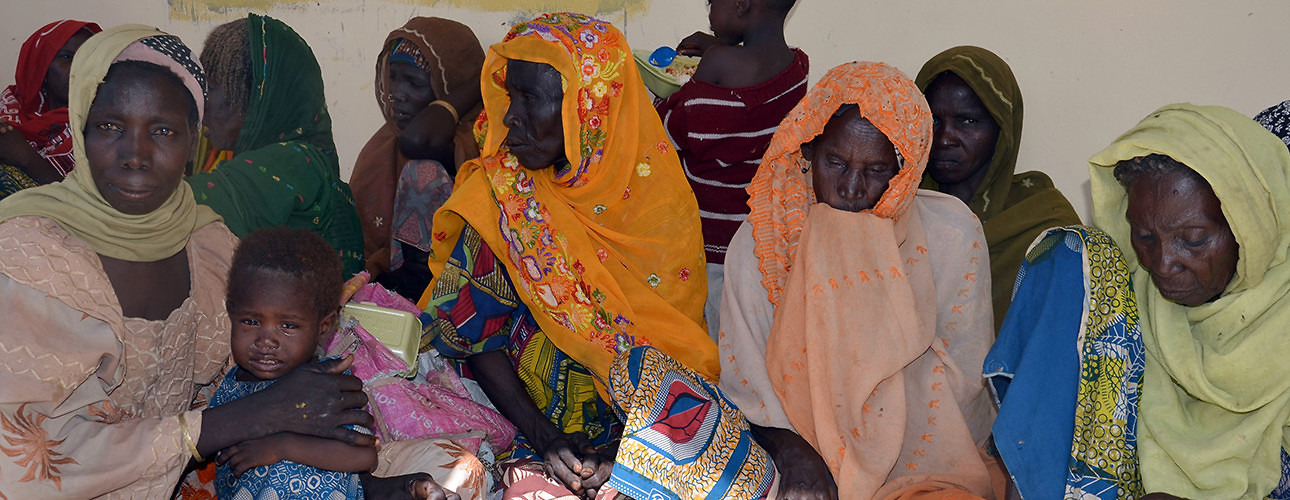Women and children rescued from Boko Haram, reportedly through military intervention, rest at a Nigerian army facility. Maiduguri, Nigeria, July 30, 2015. (Stringer/AFP/Getty Images)
On August 3, the Nigerian army reported it had freed as many as 178 captives from the clutches of Boko Haram. This was the second mass liberation of the group’s hostages in as many weeks—a cause for celebration for new Nigerian President Muhammadu Buhari, whose election platform included a firm commitment to ending the Islamist insurgency. There are, however, a number of details that cast doubt over the official accounts of the supposed breakthroughs, and whether they represent a turning point in Nigeria’s military campaign against Boko Haram.
According to military spokesman Colonel Tukur Gusau, the most recent hostage release was secured through the “besiegement” of a Boko Haram rebel encampment near the Borno State settlement of Aulari, 40 miles south of the state capital Maiduguri. Those rescued included 101 children, 67 women, and 10 men, while an unidentified military commander was also reportedly captured.
On July 28, at least 30 Boko Haram captives were similarly freed from captivity during an army counteroffensive on Dikwa—a town in eastern Borno State that has traded hands between militant and government forces at least three separate times.
These developments followed a resurgence in Boko Haram violence since Buhari’s inauguration on May 29, claiming the lives of more than 600 Nigerians. Adding to Buhari’s concerns, the upsurge in violence came at a time when counterinsurgency operations launched by the regime of former president Goodluck Jonathan finally appeared to be paying dividends, with the Nigerian army dislodging the insurgents from territory they ostensibly controlled in the rural northeast. In light of this, the timing of the recent liberations seems highly convenient for Buhari. Coupled with the tendency of Nigerian authorities to skew national political narratives when under pressure, should these claims be believed?
It would certainly not be the first time Nigerian authorities have provided false details around Boko Haram captives. For example, just three days after the April 15, 2014 abduction of nearly 300 schoolgirls from the town of Chibok—the subject of the Bring Back Our Girls campaign— the Nigerian army claimed to have rescued all of the abductees. However, they were quickly forced to retract this statement when family members of the hostages refuted the claims.
Attempts to verify the exact number and identities of the recently liberated hostages have been complicated by the government’s relocation and rehabilitation process. Former hostages are generally transported to congested and disorganized internally displaced persons camps dotted across the country. From here, they are sent to a secretive rehabilitation center where they receive supportive psychotherapy to allow their reintegration into society. Although an understandable course of action to both protect victims and facilitate their convalescence, the clandestine repatriation has only fueled speculation regarding the progression of the fight against the extremist sect.
In light of the lack of testimony from captives, there are significant doubts as to how the Nigerian government was able to successfully free them, when counterinsurgency operations of this nature have frequently led to significant hostage casualties in the past. In May 2015, for example, Boko Harm militants executed a large group of abductees as the Nigerian military encroached on their positions in the Sambisa Forest. The sect, or at least its purported affiliates, have similarly executed foreign kidnap victims when challenged. This includes the 2012 execution of British and Italian hostages in Sokoto. A year later, the same fate awaited a group of expatriates kidnapped by Boko Haram’s suspected offshoot Ansaru in Jama’are, Bauchi State. Although these incidents do not preclude the Nigerian’s armies successful liberation of Boko Haram captives, it does indicate that these undertakings are occurring at significant risk to civilian hostages. Or does it?
While high risk rescue operations may well be securing the release of hundreds of rebel captives, could there be another explanation for the recent liberations? It is certainly conspicuous that they coincided with the Buhari’s claims that he was open to negotiations with the insurgents, specifically regarding the release of kidnapped civilians.
Questioned on whether his regime would negotiate with Boko Haram to secure the release of the Chibok girls, Buhari said, “If we are convinced that the [Boko Haram] leadership that presented itself can deliver these girls safe and sound, we’ll be prepared to negotiate what they want.” This was in stark contrast to his pre-election stance, in which he denied his regime would enter into any negotiations. Members of Nigeria’s military brass have similarly supported the possibility of dialogue, though there has yet to be any official acknowledgment that it has taken place, and it has certainly not been cited as a contributing factor to the recent freeing of captives.
Had it occurred, however, dialogue of this nature would not be unprecedented. Writing a month after the Chibok events, I detailed how the Nigerian government and Boko Haram were “no strangers to the bargaining table” and had brokered a number of reciprocal hostage release agreements on previous occasions. In one of these incidents, civilian captives were “rescued” by Nigerian security forces a day after the government pledged to release detained Boko Haram members.
If Boko Haram had made similar demands in return for the release of the recent hostages, they might have proven unpalatable to many in Nigerian society, and countered the narrative that Buhari was prioritizing a hard-nosed military response to the insurgency.
The lack of transparent and verifiable information from the recently freed captives and Buhari’s regime invites considerable doubts of this nature. While efforts to safeguard innocent civilians subjected to Boko Haram’s brutality shouldn’t be criticized, the government continues to fuel mistrust among a population whose cooperation will be needed to provide for Boko Haram’s ultimate defeat.





